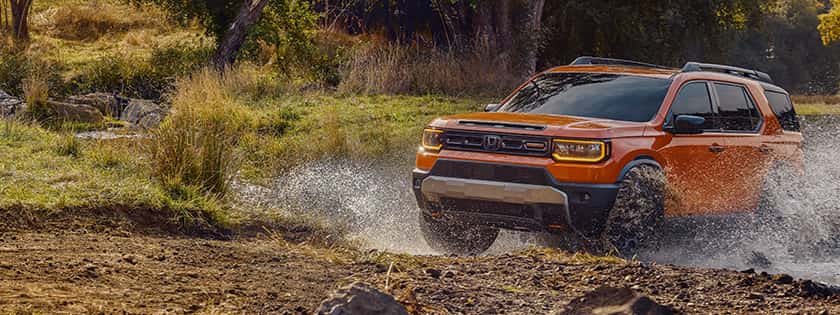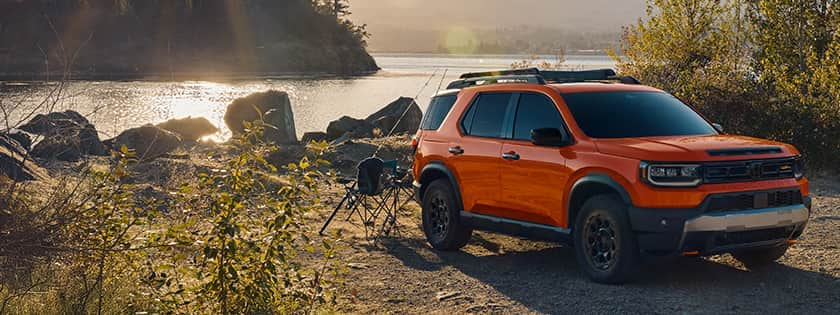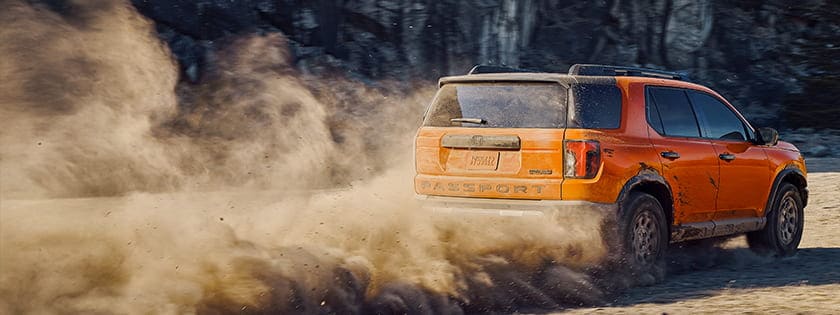
What's the deal with the 2011 Buick LaCrosse CXS? Why has it been selected for a suspension walkaround?
The 2011 LaCrosse is hiding something very interesting within its front wheel wells.
But only the CXS model has what GM calls Hiper Strut front suspension. We touched on it once before using illustrations that GM released before the car went on sale, but now we've got the real McCoy in our shop.
Let's take a look.

From here, the front end of the LaCrosse looks like a standard MacPherson strut suspension. But a hint of something unusual is peeking over the top of the brake rotor.

Here's the business end of GM's Hiper Strut suspension. The first thing to notice is the position of the strut, which hasn't moved from dead center even though the hub carrier/front upright sits at full left lock.
That's because a stubby link containing an upper ball joint juts out at the base of the strut, right where it joins the fork assembly. This upper ball joint is paired with a unique lower ball that bolts to the low end of the fork. Together these two ball joints create a much more favorable kingpin axis than anything found on a normal strut setup.
Normal struts pivot as one with the hub carrier, using the upper strut mount high in the fender as their upper pivot. In Hiper Strut-land that upper strut mount is solidly fixed and the strut itself never budges in turns. Check this out.

Here the upper ball joint defines the upper end of the kingpin axis. The strut itself only moves up and down in response to bumps.
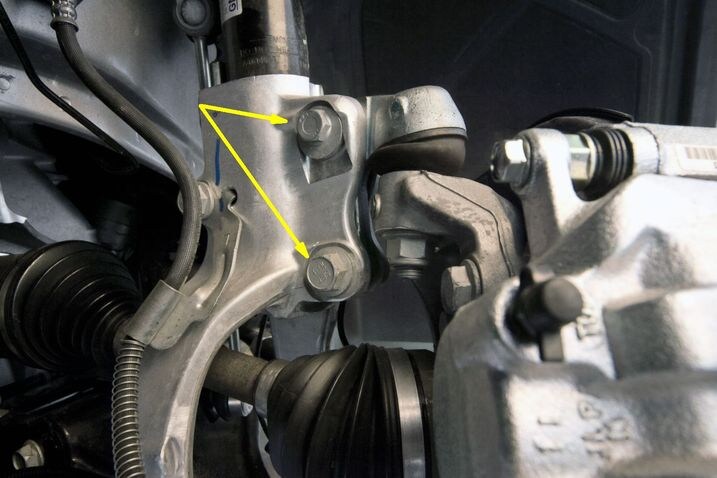
The upper ball joint sits at the end of an inverted L-shaped link. Two bolts hold it in place, the upper one an eccentric cam that allows for easy camber adjustments -- something that's usually absent on normal strut applications.

Down below, the lower control arm (yellow) has no ball joint at its end, allowing it to be attached to the fork with a simple through-bolt instead. Another stubby link containing the lower ball joint (green) bolts to the fork just above the lower control arm.

Two bolts hold the lower link and its ball joint (green) to the fork assembly. Here its a bit easier to see that it is not connected to the lower control arm (yellow) which is independently attached to the fork lower down.

We're looking at the same thing from the back this time, with the rear-mounted steering rack doing its thing. Once again the Hiper Strut's more favorable kingpin axis is highlighted.
Does it work? You bet. The Buick Lacrosse CXS's steering feels clear and precise, with good feedback and a welcome dose of self-centering. But in keeping with Buick tradition the effort isn't heavy either. Oftentimes light steering has no feel at all, but not here.
It's not just the altered steering geometry that's responsible. A simple ball joint represents much less steering friction than the usual pivoting strut top-mount. And with the strut stationary there's far less mass being twirled about.

Since the strut housing doesn't pivot, the stabilizer bar drop link (yellow) no longer needs to flop about in unison. In the CXS Hiper Strut application it's tucked around behind a bit more.

This top mount doesn't turn. But that's only true of the CXS because all other LaCrosse variants use conventional struts instead of Hiper Strut.
Incidentally, these particular CXS struts are of the conventional twin-tube variety. For another $800 the Touring Package brings continuously variable dampers to the party.

Moving on to more conventional matters, the LaCrosse CXS uses single-piston sliding front brake calipers and ventilated cast-iron rotors.

The rear of our CXS is like any other LaCrosse, but that's no bad thing because back here we find a clean-looking multilink arrangement.

We've seen variations from this before on a number of vehicles. A stout trailing arm (black) locates the wheel in the fore-aft direction and absorbs torque reactions. A single upper link orients the top of the wheel at the proper camber angle while two lower links (yellow) establish the toe-in angle and locate things at the bottom end.

Here's a better view of thise two lower links. As we've seen before, the forward one (green) is shorter than the rear one (yellow), and the difference in their two swing radii will force the outside tire to toe-in as the suspension compresses in turns. Such "roll understeer" is a very desirable trait,
If you look close you'll see that both of these links have eccentrics at their inner ends to facilitate toe and camber adjustments.
The trailing arm bolts to a cast upright (white). The rear shock (black) bolts directly to it for a damper motion ratio of about 1-to-1 -- the angle of lean being the only thing that keeps me from saying "exactly" 1-to-1.

Yes, that is a mass damper attached to the lower link mounting bolt.

Yet another view of the difference in the length of those two lower links. We can also see the bushing (yellow) that sits where the trailing link attaches to the car body.

The rearmost lower link also carries the rear coil spring loads, and from here is appears to do so at a motion ration of 0.6-to-1 or thereabouts.
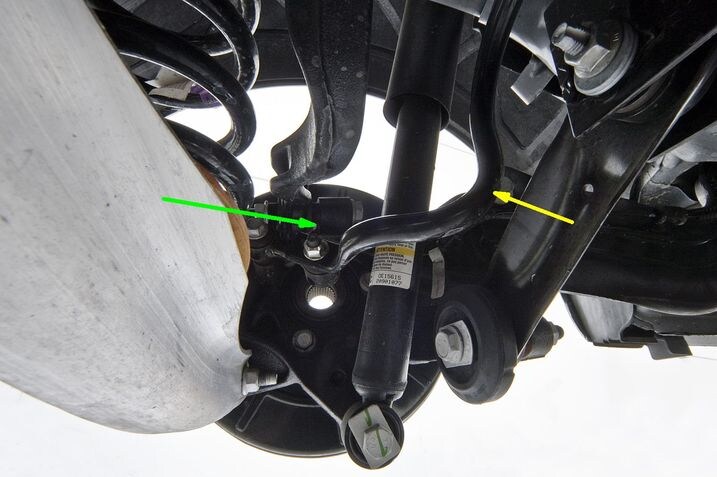
The LaCrosse's rear stabilizer bar (yellow) follows a tortured path around the shock absorber, finally meeting up with a very stubby link (green) that shares its attachment bolt with the upper link

And then we come to the brakes. These are single-piston sliding calipers and ventilated one-piece cast iron rear rotors.

Our CSX wears P235/50R18 Michelin HX MXM4 radials. If it had the $800 Touring pack it would have come with P245/40R19 tires on 19-inch wheels in addition to the aforementioned variable dampers. On the face of it that's $800 well spent, but we haven't driven that option so we can't say if it actually works or not.
The Hiper Strut suspension on the CXS seems to work quite well, so much so that this LaCrosse CXS is probably the best-steering Buick I've driven. The cost of all those extra pieces is no doubt what's restricting it to the CXS, but something that works this well doesn't deserve to be bottled up.
Early 2012 LaCrosse information we have tells us that while the LaCrosse itself isn't changing significantly for next year, the trim level nomenclature is getting a makeover. Gone for 2012 are the CXS and CXL designations because, among other things, customers couldn't tell which was the more loaded version.
Information we have on the 2012 LaCrosse tells us that the trim levels will get new names along the lines of Base, Convenience, three levels of Premium and, above them all, Touring. Hiper Strut will be fitted on the Premium 3 and Touring versions.
Also, Hiper Strut will find its way onto the front end of the 2012 Buick Regal GS.


